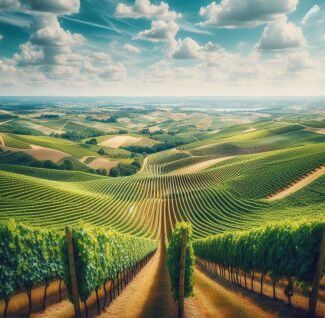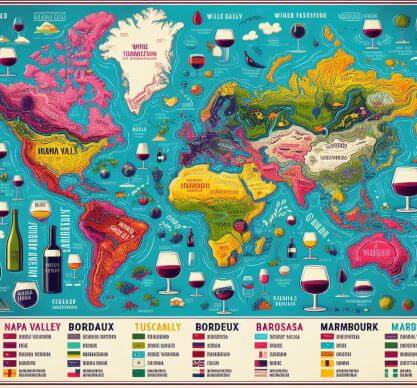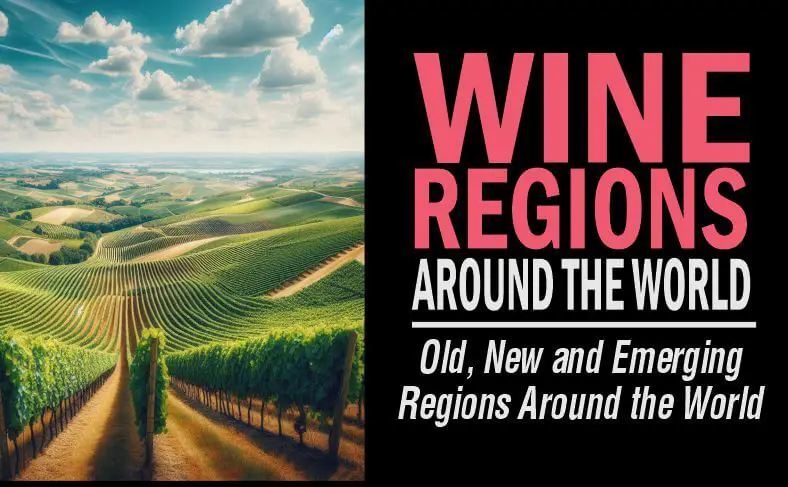Last updated on October 26th, 2025 at 06:58 pm
Let’s examine wine regions around the world, where geographical and climatic factors give rise to distinctive wine characteristics.
From the renowned vineyards of Bordeaux, Burgundy, and Tuscany in Europe to the emerging regions of California, Australia, and South Africa, each area contributes its own story through its wines.
We will discuss how terroir influences flavor profiles and enriches the wine experience with each region, so we can better appreciate the craft of winemaking.
Table of Contents
- Introduction to Wine Regions
- Old Wine Regions
- New World Wine Regions
- Emerging Wine Regions
- Factors Influencing Wine Regions
- Wine Tourism and Exploration of Wine Regions
- Benefits and Experiences of Exploring Different Wine Regions
- Scenic Beauty and Nature
- Frequently Asked Questions
- Final Word from Gentsways
Introduction to Wine Regions
Wine regions are defined areas where vineyards are cultivated and wine is produced, characterized by unique geographical and climatic factors.
The importance of these regions lies not only in the quality of wine they produce but also in their cultural and historical contexts.
Each wine region showcases a specific climate, soil type, and topography, which collectively play a role in defining the type of wines produced therein.
The Concept of Terroir
The concept of terroir is basic to understanding the wines from different regions.
Terroir has to do with the natural environment in which the grapes are grown, including the interplay of soil composition, climate, and the surrounding ecosystem.
This interaction results in unique flavor profiles that will be at variance with other wines produced from the same grape variety.
For instance, a Cabernet Sauvignon from Bordeaux will taste remarkably different from one produced in California, reflecting the local terroir’s influence.
Geographical Factors
Geographical factors such as elevation, latitude, proximity to bodies of water, and prevailing winds all contribute to the growing conditions for grapevines.
Warm climates may promote ripeness and sweetness, while cooler areas often yield grapes with higher acidity, an important element in balancing flavor profiles.
Soil types, ranging from clay and limestone to granite and gravel, provide essential nutrients to grapevines and further shape the wines’ characteristics.
Old Wine Regions
Old World wine regions are the historic wine-producing areas of Europe, including countries like France, Italy, Spain, Germany, and Portugal.
These regions have a long history of wine production dating back thousands of years and are known for their traditional winemaking practices and terroir-driven wines.
Each Old World region has its unique grape varieties, styles, and regulations that define their winemaking traditions.
France is famous for regions like Bordeaux, Burgundy, and Champagne, while Italy is known for Tuscany and Piedmont.
Spain boasts Rioja and Ribera del Duero, while Germany excels in Riesling production.
These regions have shaped the wine industry and continue to produce some of the world’s finest wines.
Wine Terminologies You Should Master
Sparkling Red and Lambrusco – Are they the Same?
Salmon-wine Pairing Guide for Gentlemen
Basics of Food and Wine Pairing
White Wines: Everything to Know
The Red Wine, Types and Characteristics
1. Bordeaux

One of the most famous wine regions in the world is Bordeaux, located in southwestern France.
Bordeaux is divided into several sub-regions, each known for its distinctive style of wine.
The region is renowned for its red wines, especially those made from the Cabernet Sauvignon and Merlot grape varieties.
Bordeaux wines are often described as elegant, with a balance of fruit, tannin, and acidity that allows them to age gracefully.
The region is also known for its white wines, particularly those made from the Semillon and Sauvignon Blanc grapes.
Champagne
Champagne is a renowned wine region in northeastern France, widely recognized for its production of sparkling wine.
It is protected by the Appellation d’Origine Contrôlée (AOC) designation, ensuring the exclusive use of Champagne for sparkling wine produced in this region.
Champagne’s climate is ideal for growing grapes, with its chalky soil providing unique mineral characteristics.
The famous champagne houses, like Moët & Chandon and Dom Pérignon, produce premium-quality bubbling wines that have become synonymous with celebration and luxury.
Burgundy
Moving to the neighboring region of Burgundy, we find yet another renowned wine region.
Burgundy is famous for its Pinot Noir and Chardonnay wines, which are considered some of the best in the world.
The region’s unique climate and limestone-rich soil contribute to the elegance and complexity of its wines.
One of the key distinctions in Burgundy is the concept of terroir, where specific vineyards are known for producing wines with distinct characteristics, referred to as “climate.” This attention to detail and emphasis on specific vineyard sites sets Burgundy apart from other wine regions.
Piedmont
Piedmont, located in northwest Italy, is renowned for its exceptional wines.
It is characterized by its hilly landscape, providing ideal conditions for grape cultivation.
Barolo and Barbaresco are notable red wines from the Nebbiolo grape variety, characterized by their full-bodied and intense flavors.
Gavi, made from the Cortese grape, is a celebrated white wine known for its crispness and elegance.
Piedmont wines consistently showcase Italy’s winemaking excellence.
Douro Valley
In addition to these well-known wine regions, there are countless others around the world that are less celebrated but equally deserving of recognition.
For example, the Douro Valley in Portugal is famous for its port wines.
The steep, terraced vineyards along the Douro River create a dramatic landscape and produce wines that are rich, complex, and often fortified.
The region has a long history of winemaking, with many vineyards passed down through generations of winemakers.
The dedication and passion of these producers have made the Douro Valley a must-visit destination for every wine enthusiast.
Tuscany
Within each wine region, countless smaller appellations and sub-regions further contribute to the diversity of the wine world.
For instance, in Italy’s Tuscany, the Chianti Classico region stands out for its Sangiovese-based wines.
With its distinctive black rooster emblem, Chianti Classico ensures a commitment to quality and tradition.
Elsewhere in Italy, the region of Piemonte is renowned for its Barolo and Barbaresco wines, both made from the Nebbiolo grape variety.
These wines are known for their complexity, structure, and ability to age for many years.
Rioja

The Rioja wine region is located in northern Spain and is one of the country’s most renowned wine regions.
It is known for producing high-quality, age-worthy red wines made primarily from the Tempranillo grape variety.
Rioja wines are known for their rich and complex flavors, with notes of dark fruit, oak, and spice.
The region has a long winemaking history dating back centuries and is divided into three sub-regions:
- Rioja Alta
- Rioja Alavesa, and
- Rioja Oriental.
Each sub-region has its own unique climate and soil conditions, contributing to the diversity of Rioja wines.
Ribera del Duero
Ribera del Duero is a renowned wine region located in the heart of Spain, along the Duero River.
It is known for producing exceptional red wines, primarily made from the Tempranillo grape variety, locally known as Tinto Fino.
The region’s high altitude, continental climate, and diverse soils contribute to the distinctive character of Ribera del Duero wines, which are often full-bodied, rich in fruit flavours, and exhibit elegant tannins.
The region is recognized worldwide for its commitment to quality winemaking practices.
Rhine and Moselle
The Rhine and Moselle wine region is located mainly in Germany and is renowned for its cool climate wines.
The region is characterized by steep vineyard slopes along the rivers Rhine and Moselle, which provide favorable growing conditions for grapes.
The wines produced here, such as Riesling, are known for their high acidity and delicate flavors.
This region is highly regarded for producing some of the finest and most aromatic white wines in the world.
Related: How to Pair Wines with Harm
New World Wine Regions
New World wine regions are non-European wine-producing areas, often characterized by their innovative and modern approaches to winemaking.
These regions, including Australia, New Zealand, the United States, Chile, South Africa, and Argentina, have emerged as major players in the global wine market.
With diverse climates and terroirs, they produce a wide range of varietals, showcasing their distinct styles and flavors.
New World wine regions often embrace technology, experimentation, and sustainability, attracting both traditionalists and wine enthusiasts seeking something new and exciting in the world of wine.
1. Napa Valley

Continuing our journey, we cross the Atlantic to explore the Napa Valley in California.
Napa Valley is synonymous with world-class wines and is renowned for its Cabernet Sauvignon and Chardonnay varieties.
The region benefits from its Mediterranean climate, with warm days and cool nights that allow the grapes to ripen slowly, resulting in full-bodied wines with rich flavors and fine tannins.
The wineries in Napa Valley are known for their commitment to quality and innovation, constantly pushing the boundaries of winemaking.
Related: Lamb and Wine Pairing Guide
2. Argentina and Chile
Heading south to the southern hemisphere, we find the wine regions of Argentina and Chile.
These countries are known for producing bold, fruit-forward wines that have gained international acclaim.
Argentina’s Mendoza region is famous for its Malbec wines, known for their dark fruit flavors, velvety texture, and robust character.
Chile’s Central Valley, on the other hand, is known for its Carmenere wines, a grape variety originally from Bordeaux but now almost exclusively grown in Chile.
These wines are often described as spicy, soft, and full-bodied.
3. Australia
Australia is a renowned wine region known for its diverse and high-quality wines.
With over 60 designated wine regions spread across the continent, it offers a wide range of grape varieties and styles.
The warm climate in many areas allows for ripe fruit flavors, while cool climate regions produce elegant and aromatic wines.
Iconic grape varieties like Shiraz, Cabernet Sauvignon, Chardonnay, and Riesling thrive here.
Australia’s wine industry has a rich history, incorporating innovative techniques and modern winemaking practices, making it a prominent player in the global wine market.
4. New Zealand
New Zealand is a renowned wine region that is known for its high-quality and distinct wines.
The country’s cool climate and diverse geography create the perfect conditions for grape cultivation, particularly in regions such as Marlborough, Hawke’s Bay, and Central Otago.
Sauvignon Blanc is the country’s most famous and successful varietal, with its vibrant and zesty flavors.
New Zealand also produces excellent Pinot Noir, Chardonnay, and Riesling, among other varieties.
The wines from New Zealand are celebrated for their freshness, purity, and approachability, making them a favorite choice among wine enthusiasts worldwide.
5. South Africa
South Africa is a thriving New World wine region known for its diverse geography and cool climate conditions, resulting in unique and high-quality wines.
The country’s wine industry is experiencing significant growth with a focus on innovative winemaking techniques and sustainable practices.
South African wines showcase a wide range of grape varietals, from classic offerings like Chenin Blanc and Cabernet Sauvignon to lesser-known gems like Pinotage.
With its rich history and modern approach to winemaking, South Africa is rapidly establishing itself as a top destination for wine enthusiasts.
Emerging Wine Regions
Emerging wine regions are areas that have recently gained recognition for producing high-quality wines and are considered to be growing in importance within the global wine industry.
These regions often have unique characteristics that allow them to produce distinctive styles of wine.
They may have favorable climates, specific soil types, or a combination of factors that contribute to the production of exceptional wines.
Examples of up-and-coming wine regions are:
1. Finger Lakes, New York, USA
The Finger Lakes region in upstate New York has emerged as a notable wine region, particularly known for its production of world-class Riesling wines.
The area benefits from its cool climate, deep lakes, and sloping terroir, which create ideal conditions for grape cultivation.
It has gained recognition for its high-quality wines and has become a popular tourist destination for wine lovers.
2. Ningxia, China
Ningxia, located in northwest China, is considered one of the most promising emerging wine regions in the country.
It has a continental climate with hot summers and cold winters, which provides optimal conditions for vine growth.
Ningxia has gained attention for its production of Cabernet Sauvignon and other Bordeaux-style wines.
The region’s wine industry has grown rapidly in recent years, and its wines have achieved international recognition and awards.
3. Swartland, South Africa
Swartland, situated in the Western Cape province of South Africa, has emerged as an exciting wine region known for its unique terroir and diverse range of grape varieties.
The region’s hot, dry climate and ancient granite and shale soils contribute to the production of rich, full-bodied wines.
In recent years, Swartland has attracted a new generation of winemakers who have focused on producing high-quality, terroir-driven wines, especially from varieties like Shiraz, Chenin Blanc, and Grenache.
Factors Influencing Wine Regions

Of course, wine regions have dynamics that make them produce grapes for wine-making.
These factors become negative or positive influences and affect the quality and abundance of the grapes.
Let’s take a closer look:
1. Climate
The climate of a region significantly impacts the growth and quality of grapes.
Factors such as temperature, sunlight, rainfall, and wind patterns affect the ripening process, acidity, sugar levels, and overall character of the grapes.
2. Soil and Terroir
Different soil types and compositions play a crucial role in the flavors and qualities of wine.
Soil characteristics like drainage, water retention, mineral content, and pH levels influence the vine’s root structure, nutrient uptake, and ultimately the taste profile of the grapes.
3. Grape Varieties
Different grape varieties have distinct characteristics, flavors, and growth requirements.
The choice of grape varieties in a wine region is influenced by factors such as historical cultivation preferences, adaptation to local climate and soil conditions, and market demand.
4. Winemaking Techniques
The techniques used during the winemaking process, such as fermentation, aging, blending, and oak barrel usage, greatly impact the final flavor and style of the wine.
Different regions may have their traditional winemaking techniques that have been perfected over time and contribute to a unique regional identity.
Wine Tourism and Exploration of Wine Regions
Wine tourism is a form of tourism that revolves around visiting wineries and vineyards, as well as tasting and experiencing different wines and the culture surrounding them.
It includes activities such as vineyard tours, wine tastings, wine festivals, and exploring regions of wine production.
Wine tourism offers an opportunity to learn about the production process, indulge in local cuisine and wine pairings, and enjoy the scenic beauty of vineyard landscapes.
Importance of Wine Tourism for Wine Regions
- Wine tourism plays a significant role in boosting the local economy of wine regions.
- It generates revenue not only through tourism-related activities but also by increasing sales of local wines and supporting local restaurants, accommodations, transportation, and other businesses.
- Wine tourism helps to promote and establish the reputation of a wine region. By attracting visitors from around the world, it creates an opportunity to showcase the unique characteristics and quality of the local wines.
- Wine tourism helps to preserve and promote the local traditions, customs, and unique winemaking techniques, ensuring the continuation of these cultural elements for future generations.
- Wine tourism can encourage sustainable practices in wine regions. Many wineries are adopting environmentally friendly methods for cultivating grapes and producing wine.
Tips for Planning a Wine Tour or Trip
1. Research and Plan Ahead: Before traveling to a wine region, conduct thorough research on wineries, wine routes, accommodations, and other attractions. Decide which wineries or vineyards you would like to visit, determine if advanced reservations are required, and plan your itinerary accordingly.
2. Consider Season and Timing: Wine regions vary in terms of their seasons and peak harvest periods. Consider visiting during the harvest season to experience the lively atmosphere and get a chance to participate in grape picking or winemaking activities.
3. Seek Expert Opinions: Consult local wine experts or tour operators to get recommendations on wineries, wine tastings, or events. They can provide valuable insights and help you make the most of your wine tour.
4. Pace Yourself and Stay Hydrated: Wine-tasting tours can be enjoyable but can also be physically challenging if not managed properly. Pace yourself and avoid overindulging in wine. Drink water between tastings to stay hydrated.
Benefits and Experiences of Exploring Different Wine Regions
Taste and Discover New Wines
Exploring different wine regions exposes you to a wide range of wines, grape varietals, and winemaking techniques.
You can taste unique, local wines that may not be available in your home region, expanding your wine knowledge and palate.
Immersive Cultural Experiences
Wine regions often offer cultural experiences beyond wine tasting.
You can learn about the history, art, cuisine, and traditions of the region while exploring vineyards, visiting historic wineries, and engaging with locals.
Scenic Beauty and Nature
Many regions of wine production are located in picturesque settings, featuring stunning landscapes, rolling vineyards, and beautiful countryside.
Exploring these regions allows you to enjoy the natural beauty and tranquility of the surroundings.
Gastronomic Delights
Wine regions are usually known for their culinary offerings.
You can pair local wines with regional cuisine, indulge in wine and food pairing experiences, or even participate in cooking classes to learn about the local gastronomic culture.
Engaging with Winemakers and Experts
Exploring wine regions allows you to meet winemakers, vineyard owners, and wine experts who are passionate about their craft.
You can learn directly from them about the winemaking process, and the intricacies of wine tasting, and gain insights into the local industry.
Frequently Asked Questions
Which wine region is known for producing high-quality red wines?
Bordeaux, France, is renowned for its red wines, particularly Cabernet Sauvignon and Merlot blends.
What is the main grape variety grown in Italy’s Tuscany wine region?
Sangiovese is the predominant grape variety in Tuscany, used to produce famous wines like Chianti and Brunello di Montalcino.
What distinguishes Napa Valley as a prominent wine region in California?
Napa Valley is known for its diverse microclimates, producing exceptional Cabernet Sauvignon due to its ideal soil conditions and temperature variations.
What wine region in Australia is celebrated for its Shiraz wines?
The Barossa Valley in Australia is renowned for its rich and robust Shiraz, with its warm climate and old-vine vineyards contributing to their intense flavours.
Which South American country is making waves in the wine world?
Argentina’s Mendoza region is gaining recognition with its Malbec wines, offering a unique expression of the grape due to the high altitude and sunny climate.
Final Word from Gentsways
The world is blessed with a plethora of wine regions, each offering unique and exceptional varieties.
From the Old World charm of Europe to the emerging regions in the New World, wine enthusiasts are spoilt for choice.
Exploring the diverse terroirs and climates, one can experience the perfect harmony of nature and craftsmanship in every glass.
So whether you’re savouring a bold red from Napa Valley or a crisp white from Marlborough, wine regions around the world offer an endless journey of discovery for all palates to enjoy.
References:
- https://winefolly.com/lifestyle/top-wine-regions-of-the-world/
- https://andreawine.com/wine-course-overview-of-new-world-wine-regio
- https://www.independent.co.uk/travel/food-drink/best-wine-regions-b2411314.html
- https://www.quora.com/How-many-wine-regions-are-there-in-the-world
Pyo Merez is a men’s lifestyle enthusiast and writer about the gentleman’s place and impact on society. Raised by a distinguished gentleman dad, he offers unique insights into how the mind of a gentleman works and how societal norms shape gentlemen’s identity and vice versa.
Through his insightful articles, Pyo taps into the depths of gentleman culture to provide perspectives on etiquette and manners in modern society.

